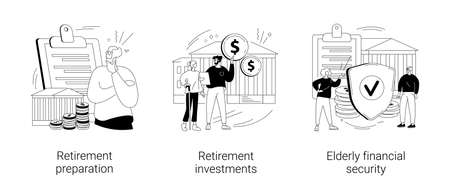1. Introduction to Pension Plans
Planning for retirement is one of the most important financial steps you can take in your life. A pension plan is a key component of retirement planning, designed to provide financial security after you stop working. Understanding how pension plans work and how they compare to other retirement savings options can help you make informed decisions about your future.
What Is a Pension Plan?
A pension plan is a retirement savings program that provides regular income to retirees, typically funded by employers, employees, or both. These plans are designed to ensure financial stability in retirement by offering a steady stream of income once an individual stops working.
Why Are Pension Plans Important?
Pension plans play a crucial role in ensuring financial security during retirement. Here are some key reasons why they matter:
- Guaranteed Income: Pension plans often provide a predictable and stable income stream.
- Employer Contributions: Many pension plans include employer contributions, which help boost retirement savings.
- Long-Term Security: Unlike other investment-based retirement accounts, pensions typically offer lifetime benefits.
How Do Pension Plans Differ from Other Retirement Savings Options?
Pension plans are just one of several ways to save for retirement. Below is a comparison between pension plans and other common retirement savings options:
| Retirement Option | Who Contributes? | Payout Type | Risk Level |
|---|---|---|---|
| Pension Plan | Employer & Employee | Fixed Monthly Payments | Low (Employer Manages Investments) |
| 401(k) Plan | Employee (Employer May Match) | Lump Sum or Withdrawals | Medium to High (Market-Dependent) |
| IRA (Individual Retirement Account) | Employee Only | Lump Sum or Withdrawals | Medium to High (Self-Managed Investments) |
| Annuities | Employee Only | Regular Payments (Based on Contract Terms) | Varies (Depends on Type of Annuity) |
Types of Pension Plans
(1) Defined Benefit Plans
This type of pension plan guarantees a specific payout at retirement, usually based on salary history and years of service. The employer bears the investment risk and ensures retirees receive their promised benefits.
(2) Defined Contribution Plans
In these plans, both employees and employers contribute funds to an individual account. The final amount available at retirement depends on contributions made and investment performance over time.
(1) 401(k) Plans
A popular defined contribution plan where employees contribute pre-tax dollars, often with employer matching contributions.
(2) 403(b) Plans
A similar option for employees of nonprofit organizations and public schools, allowing tax-deferred savings growth.
(3) Profit-Sharing Plans
An employer-funded plan where contributions depend on company profits.
Pension plans are a fundamental part of retirement planning, offering financial security and long-term stability. Understanding their features and differences compared to other retirement savings options will help you build a solid foundation for your future.
2. Types of Pension Plans
When planning for retirement, understanding the different types of pension plans can help you make informed financial decisions. Pension plans generally fall into three main categories: defined benefit plans, defined contribution plans, and hybrid pension plans. Each type has distinct features, benefits, and potential drawbacks.
Defined Benefit Plans
Defined benefit (DB) plans provide retirees with a guaranteed payout based on factors such as salary history and years of service. Employers primarily fund these plans and assume the investment risk.
Key Features of Defined Benefit Plans
- Guaranteed lifetime income for retirees
- Employer-funded with minimal employee contributions
- Benefits calculated using a formula based on salary and years of service
- Employer assumes investment risk
- Subject to vesting requirements before employees qualify for full benefits
Defined Contribution Plans
Defined contribution (DC) plans, such as 401(k)s, rely on employee contributions with potential employer matching. The final retirement benefit depends on investment performance.
Key Features of Defined Contribution Plans
- Employee and sometimes employer contribute to the plan
- Retirement savings grow based on investment returns
- No guaranteed payout; depends on market performance
- Employees bear investment risks
- Funds can be withdrawn at retirement, subject to tax rules
Hybrid Pension Plans
Hybrid pension plans combine elements of both DB and DC plans to balance risk and reward between employers and employees.
Common Types of Hybrid Plans
- Cash Balance Plans: These operate like DB plans but define benefits as an account balance that grows over time.
- Pension Equity Plans: Benefits are determined by a percentage of final salary multiplied by years of service.
- Combination Plans: Employers offer both DB and DC components to provide a mix of security and flexibility.
Pension Plan Comparison Table
| Pension Type | Main Funding Source | Payout Structure | Risk Bearer | Flexibility |
|---|---|---|---|---|
| Defined Benefit Plan | Employer-funded | Guaranteed lifetime payments | Employer bears investment risk | Less flexible for employees |
| Defined Contribution Plan | Employee & employer contributions | No guaranteed payout; depends on investments | Employee bears investment risk | More flexibility in contributions & withdrawals |
| Hybrid Pension Plan | Employer & employee contributions vary by plan type | A mix of guaranteed benefits & account-based growth | Bears risk is shared between employer & employee depending on plan design | A balance between security & flexibility for employees |
Selecting the right pension plan requires considering factors such as job stability, retirement goals, and risk tolerance. Understanding these options can help ensure financial security in retirement.

3. How Pension Plans Work
Pension plans are a key component of retirement security, but understanding how they function can be complex. In this section, we’ll break down how pension plans are funded, how benefits are calculated, and the roles that both employers and employees play in the process.
Funding a Pension Plan
Pension plans rely on contributions from employers, employees (in some cases), and investment returns to build the funds needed for retirement payouts. The way these contributions work depends on the type of pension plan.
(1) Employer Contributions
In most defined benefit pension plans, employers contribute a set percentage of an employee’s salary into the pension fund. These contributions are invested to grow over time and ensure there is enough money to pay out future benefits.
(2) Employee Contributions
Some pension plans require employees to contribute a portion of their paycheck toward their retirement fund. These contributions may be mandatory or voluntary, depending on the plan structure.
(3) Investment Returns
The funds in a pension plan are typically invested in stocks, bonds, and other assets to generate returns. Strong investment performance helps maintain the financial health of the pension fund and ensures it can meet its obligations.
How Benefits Are Calculated
The amount you receive from a pension plan in retirement depends on several factors, including your salary history, years of service, and the plan’s formula for calculating benefits.
| Factor | Description |
|---|---|
| Years of Service | The longer you work for an employer offering a pension, the higher your benefits will typically be. |
| Salary History | Pension benefits are often based on an average of your highest-earning years. |
| Pension Formula | The formula varies by plan but usually includes a percentage multiplier based on service years and salary. |
The Role of Employers and Employees
(1) Employer Responsibilities
Employers play a crucial role in managing pension plans. They are responsible for funding the plan, making investment decisions (or hiring professionals to do so), and ensuring retirees receive their promised benefits.
(2) Employee Responsibilities
If an employee is required to contribute to their pension, they should understand how much they need to set aside. Additionally, employees should review their pension statements regularly to track their expected benefits.
4. Key Considerations for Pension Planning
Planning for retirement with a pension involves several important factors that can impact your financial security. Understanding these elements will help you make informed decisions and maximize your benefits.
Vesting Periods
Vesting refers to the amount of time you must work for an employer before gaining full ownership of pension benefits. Employers typically offer different types of vesting schedules:
| Vesting Type | Description |
|---|---|
| Cliff Vesting | You must work a set number of years before becoming 100% vested. If you leave before this period, you forfeit all benefits. |
| Graded Vesting | Your vested percentage increases gradually over time (e.g., 20% per year for five years until fully vested). |
| Immediate Vesting | You are fully vested from day one, meaning you own all contributions immediately. |
Payout Options
When it’s time to receive your pension, you’ll have different payout options. Choosing the right one depends on your financial needs and long-term goals:
(1) Lump-Sum Payment
This option allows you to receive the entire pension balance at once. It provides flexibility but requires careful management to ensure longevity.
(2) Single-Life Annuity
A fixed monthly payment for your lifetime. This maximizes payouts but does not provide benefits to survivors after your passing.
(3) Joint-and-Survivor Annuity
Provides payments for both you and a designated beneficiary (e.g., spouse). Monthly payments may be lower than a single-life annuity, but they continue after your death.
(4) Period Certain Annuity
Pays benefits for a specific period (e.g., 10 or 20 years). If you pass away during this time, beneficiaries continue receiving payments until the term ends.
Potential Risks to Consider
Pensions offer stability, but there are potential risks that could impact your retirement funds:
(1) Employer Solvency Risk
If your employer faces financial difficulties or bankruptcy, your pension benefits may be reduced or lost. Checking if your plan is covered by the Pension Benefit Guaranty Corporation (PBGC) can provide peace of mind.
(2) Inflation Risk
Pension payments may not always keep pace with inflation, reducing purchasing power over time. Some plans offer cost-of-living adjustments (COLAs), so verify if yours includes this benefit.
(3) Early Withdrawal Penalties
If you withdraw pension funds early, you may face penalties and tax implications. Understanding these rules ensures that you don’t reduce your retirement income unnecessarily.
(4) Longevity Risk
Outliving your pension savings is a concern. Choosing an annuity option or combining pensions with other retirement income sources can help mitigate this risk.
By carefully considering vesting periods, payout options, and potential risks, you can create a pension strategy that ensures financial stability in retirement.
5. Pension Plans and Social Security
Understanding how pension benefits interact with Social Security is crucial for maximizing your retirement income. While both provide financial support in retirement, their interaction can sometimes lead to reductions in benefits due to specific offset rules. Lets explore these interactions and strategies to optimize your retirement income.
How Pension Benefits Affect Social Security
If you receive a pension from work where you didn’t pay Social Security taxes, such as certain government or public sector jobs, your Social Security benefits may be reduced. This happens through two main provisions:
(1) Windfall Elimination Provision (WEP)
The WEP affects workers who receive pensions from non-Social Security-covered employment. It reduces the amount of Social Security benefits based on a formula that adjusts the primary insurance amount (PIA). However, the impact lessens if you have 30 or more years of substantial earnings under Social Security.
(2) Government Pension Offset (GPO)
The GPO applies to individuals receiving a government pension and claiming spousal or survivor benefits from Social Security. The reduction equals two-thirds of the government pension amount, which can significantly lower or even eliminate spousal or survivor benefits.
Potential Offsets and Their Impact
| Offset Rule | Who It Affects | How It Works |
|---|---|---|
| Windfall Elimination Provision (WEP) | Retirees with non-Social Security-covered pensions | Reduces personal Social Security benefits based on years of covered work |
| Government Pension Offset (GPO) | Spouses or survivors receiving a government pension | Cuts spousal/survivor benefits by two-thirds of the pension amount |
Strategies to Maximize Retirement Income
(1) Work More Years Under Social Security
If possible, working additional years in a job covered by Social Security can reduce or eliminate WEP penalties, especially if you reach 30 years of substantial earnings.
(2) Delay Social Security Benefits
Delaying your Social Security claim until full retirement age or later increases your monthly benefit amount, helping offset any reductions caused by WEP or GPO.
(3) Plan for Additional Retirement Savings
If your pension reduces your expected Social Security income, consider contributing more to tax-advantaged accounts like 401(k)s or IRAs to supplement your retirement funds.
6. Maximizing Your Pension Benefits
Getting the most out of your pension plan requires careful planning and informed decision-making. Whether youre considering early retirement, evaluating spousal benefits, or understanding tax implications, there are several strategies to ensure you maximize your pension income.
Early Retirement Considerations
Retiring early may seem appealing, but it comes with financial trade-offs. Here are some key factors to consider:
- Reduced Monthly Payments: Many pension plans reduce benefits if you retire before the standard retirement age.
- Eligibility Requirements: Some plans require a minimum number of service years to qualify for full benefits.
- Healthcare Costs: Retiring early may mean losing employer-sponsored health coverage, requiring alternative insurance options.
Understanding Spousal Benefits
If youre married, spousal benefits can impact your pension choices. Consider these options when selecting a payout plan:
| Payout Option | Description |
|---|---|
| Single-Life Annuity | Pays benefits only during your lifetime; higher monthly payments but no spousal benefits after your passing. |
| Joint-and-Survivor Annuity | Pays a reduced monthly amount but continues providing payments to your spouse after your death. |
| Lump-Sum Payout | A one-time payment instead of monthly benefits; offers flexibility but requires careful financial management. |
Tax Implications of Your Pension
Your pension income is generally subject to federal and state taxes. Here’s what you need to know:
(1) Tax Withholding on Pension Payments
Pension payments are typically taxed as ordinary income. You can adjust withholding amounts based on your expected tax liability.
(2) State Taxes on Pensions
Some states do not tax pension income, while others partially or fully tax it. Check your state’s tax laws to understand potential deductions or exemptions.
(3) Required Minimum Distributions (RMDs)
If you have a pension combined with other retirement accounts like a 401(k) or IRA, you must take RMDs starting at age 73 (as of 2024). Failing to do so results in penalties.


